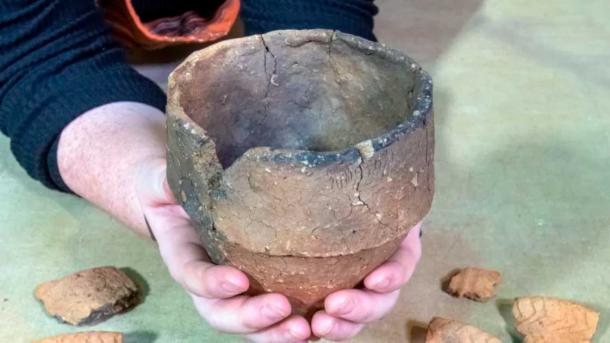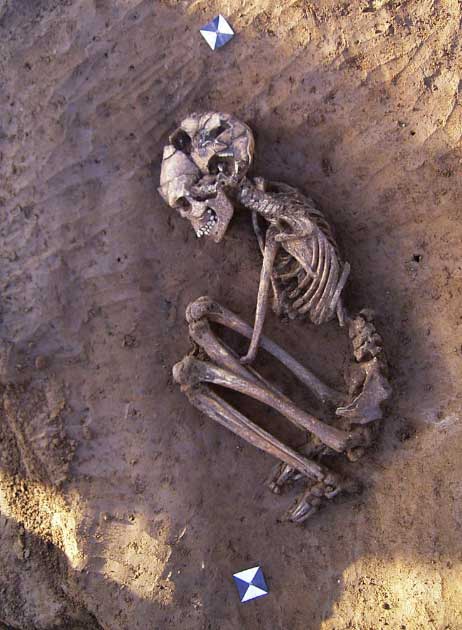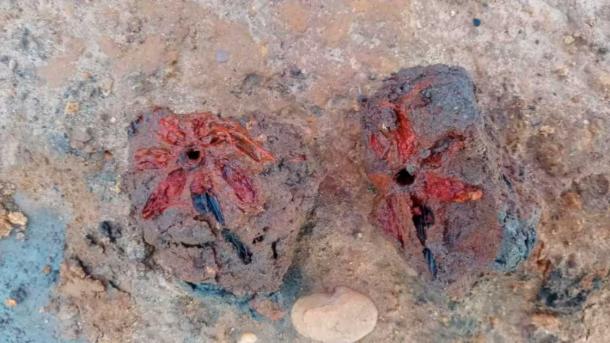
Highly Significant Bronze Age and Roman Ritual Center Discovered in England
A team of archaeologists from the Museum of London Archaeology (MOLA) have uncovered a 4,000-year-old treasure trove of ritual and religious activity in Overstone, near Northampton, England. This ancient site, which was in use for over 2,000 years, was found to be centered around a natural spring and has yielded both Bronze Age and Roman artifacts.
As Simon Markus from MOLA explained to the BBC, the site would have been "a highly significant place for local ancient communities." The team, working ahead of new housing development in the village, made a series of intriguing discoveries. The oldest find was a Bronze Age barrow, a type of ancient burial mound, built between 2000 BC and 1500 BC. However, unlike most barrows, this one did not contain any human remains, only five empty burial urns, leading Markus to suggest that it may have had a more symbolic, rather than functional, use.
- A Return to Ancient Burial Traditions: Want to Be Buried in a Barrow?
- Study Finds Huge Undetected Migration Wave to Prehistoric Britain

Five empty Bronze Age burial urns were excavated from the Northampton site, suggesting it was a symbolic site. The area was later developed into a Roman ritual center. (Museum of London Archaeology)
Bronze Age Discoveries
A number of Bronze Age discoveries have already been made in Northampton, which have provided an insight into the lives and cultural practices of the people who lived in the area during the Bronze Age.
One notable discovery was a Bronze Age settlement at Duston, Northampton where a large number of roundhouses were excavated. These roundhouses were likely the homes of Bronze Age people. Also, several Bronze Age objects were found, including a sword and axe head; these objects indicate the skill of the people of this era in metalworking.
A Bronze Age burial site was also discovered at Sixfields, Northampton in the 20th century. The site contained the remains of several individuals buried in crouched positions, which is a typical feature of Bronze Age burials.
- The Bronze Age - A Spark That Changed the World
- Civilization's Midnight: The Late Bronze Age Collapse

Bronze Age burials are frequently identifiable by the crouched position of the remains. This teenaged girl was buried in Wessex circa 1000 BC. (Wessex Archaeology / CC BY NC SA 2.0)
Romans in Northampton
Arkeonews has reported that MOLA also uncovered an unusual stone building from the Roman period (43 AD – 410 AD) in Overstone, which was decorated with elaborately painted plasterwork and possibly a painted ceiling. The building appeared to have no functional use and is believed to have been a shrine associated with the nearby spring. Alongside the building, large water tanks were found, containing 2,000-year-old organic remains of willow tree blossoms, pinecones, walnut shells, and even a complete leather shoe.

The Roman ritual center was located near a spring. Among the remains found in a water tank was a 2,000-year-old flower, preserved by the waterlogged soil conditions. (Museum of London Archaeology)
Roman activity in Northampton, England can be traced back to the Roman conquest of Britain in the 1st century AD. The Romans established a settlement in the area, known as a "vicus," which was a civilian settlement located outside a military fortress. The settlement was likely established to serve the soldiers stationed at the nearby Roman fortress of Longthorpe. Excavations in Northampton have revealed the presence of Roman pottery, building materials, and coins, indicating that there was a significant Roman presence in the area.
One of the most notable Roman finds in Northampton was a Roman town house that was discovered in the 1970s. The house was built in the 2nd century AD and was in use for about 200 years. It was a large, luxurious building with mosaic floors, painted walls and an elaborate heating system. The house provides a glimpse into the lives of the wealthy Roman residents of Northampton.
Additionally, Roman artifacts have been discovered in the surrounding area, including a Roman villa in nearby Duston and a Roman settlement at Far Cotton. These finds suggest that the Romans had a significant presence in the region and engaged in agriculture and trade.
Excavation Continues at the Ritual Center
The team from MOLA is excited to continue working on this site and will now focus on the environmental remains preserved by the spring. This ancient site is a window into the past, providing a glimpse of the religious and ritual practices of the people who lived here thousands of years ago.
Top Image: A Roman ritual center has been discovered in Northampton, which had been in use since the Bronze Age. Source: International Council of Museums / Twitter
By Ashley Cowie
References
Archaeologists discover Roman 'ritual centre' at Overstone. January 10, 2023. BBC. Available at: https://www.bbc.com/news/articles/ce9z0pj7vd1o
Büyükyıldırım, O. January 12, 2023. Roman ‘ritual center’ discovered in England. ArkeoNews. Available at: https://arkeonews.net/roman-ritual-center-discovered-in-england/
















Comments
So they keep digging down into the Earth and finding caverns where people were living, and where people died. So, are we supposed to believe that when the Romans left, they had people bury the site under who knows how many feet of dirt? Ridiculous, no?
And here/now this: “However, unlike most barrows, this one did not contain any human remains, only five empty burial urns , leading Markus to suggest that it may have had a more symbolic, rather than functional, use." So they did all that work, dug it all out, outfitted it with implements of the day, ...but not for the function of living down there, but something symbolic? Symbolic of what, insanity?
Okay, let’s add some logic: What would it take for people to perish together down in their caverns, with all their stuff, and then have it covered up for many feet of dirt? Time alone cannot add the dirt. Only two explanations are plausible: 1) That people intentionally shovelled that dirt overtop (but we are stretching the concept of plausibility); or 2) that the glaciers from the Ice Age did it. So somebody should question the dates. These people are probably Atlantean era/pre-Ice Age (circa 115k BC adding the zero back to Plato's timeline), who all perished at the same time, suddenly, in some global cataclysm that suddenly precipitated the long 'nuclear winter'.
But let's do the DNA analysis, and find out hair and eye color. That might be key to getting to 'the bottom' of things.
Nobody gets paid to tell the truth.